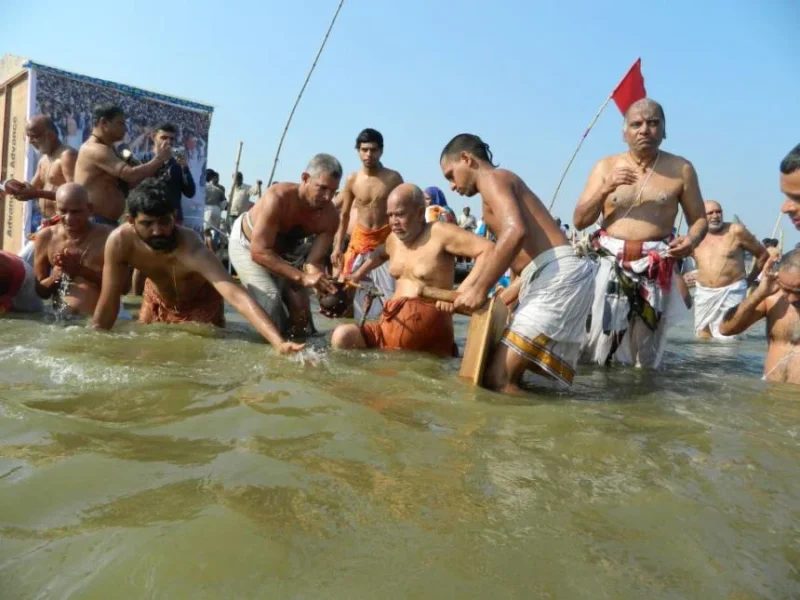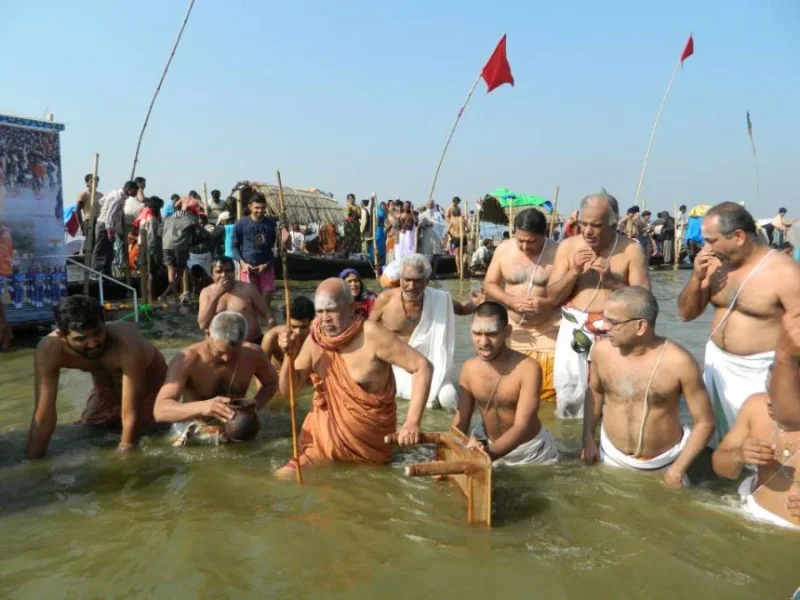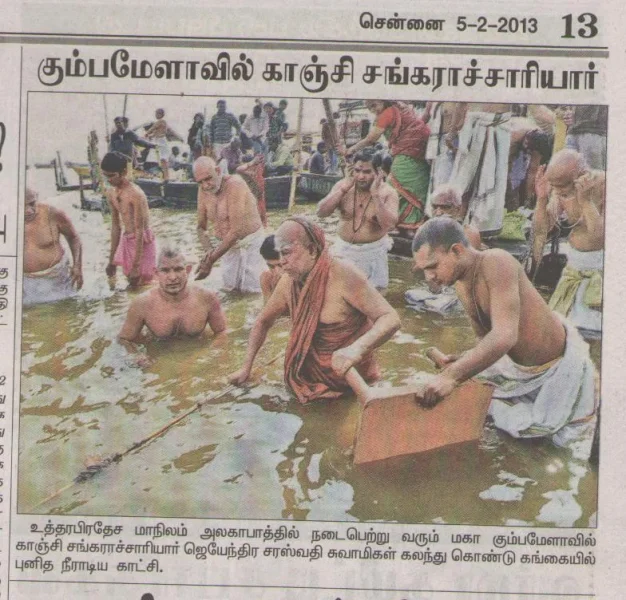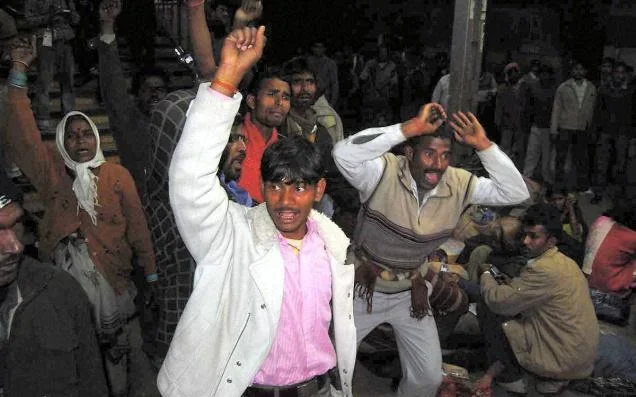[TD="align: left"]
For up to 80 million pilgrims-think 10 New York Cities-a Hindu festival now taking place on the banks of the Ganges River in Allahabad, India, is a chance to wash away their sins under ideal astrological conditions.
[/TD]
[TD="width: 100%, bgcolor: #FFFFFF, align: left"]
For Suresh Dwivedi, chief medical officer at what is called the Kumbh Mela, the festival is a full-scale assault on the germs, garbage and human waste being generated in the temporary megacity that has been constructed to deal with the crowds.
[/TD]
[TD="width: 100%, bgcolor: #FFFFFF, align: left"]
To combat disease-carrying flies, 400 laborers will spray 28 tons of bleaching powder, along with the insecticide DDT, over 250 garbage pits and open drains during the course of the two-month extravaganza. They will work alongside 6,000 cleaners in green baseball caps who sweep up 56 tons of garbage a day and bury human waste left in the open (a common practice in rural India) in 4,000 chemically treated pits.
[/TD]
[TD="width: 100%, bgcolor: #FFFFFF, align: left"]
"If we can keep the area clean and the flies away, then we will be able to keep infections away," says Mr. Dwivedi. His greatest concern is preventing the outbreak of disease.
[/TD]
[TD="width: 100%, bgcolor: #FFFFFF, align: left"]
The Kumbh Mela-which translates as "water-pitcher festival"-is almost certainly the largest religious gathering on earth, and preparing for it, running it, and preventing it from turning into fatal chaos is surely one of the world's great logistical challenges.
[/TD]
[TD="width: 100%, bgcolor: #FFFFFF, align: left"]
"It's an amazing operation to deploy a city on this scale for 55 days," says Rahul Mehrotra, chairman of the department of urban planning and design at the graduate school of design at Harvard University.
[/TD]
[TD="width: 100%, bgcolor: #FFFFFF, align: left"]
His team has been studying the Kumbh Mela's construction since July. Prof. Mehrotra says that the city is unique not just because of the number of people who gather there but because it is arranged like a more permanent community. "Spatially, it is organized into zones with a use of infrastructure that replicates a regular, efficient urban condition," he says.
[/TD]
[TD="width: 100%, bgcolor: #FFFFFF, align: left"]
The festival, which started on Jan. 14 and runs to March 10, is believed to be at least two millennia old. It attracts an eclectic stew of Hindu holy men, Bollywood stars, ordinary pilgrims and curious tourists who come to bathe in the Ganges, India's holiest river, where drops of the nectar of immortality are believed to have been spilled from a pitcher by the gods at creation.
[/TD]
[TD="width: 100%, bgcolor: #FFFFFF, align: left"]
Hindus say that dipping in these waters during the festival, when the sun and Jupiter are in auspicious alignment, will free them from the cycle of reincarnation.
[/TD]
[TD="width: 100%, bgcolor: #FFFFFF, align: left"]
Rukomani Devi, 50, has traveled for 24 hours by train to plunge into the murky waters. Her wet yellow sari clings to her as she steps out of the river onto its artificially reinforced banks. After changing beneath a thin towel she begins a riverbank ritual with incense, flowers, candles, prayers and water in praise of Mother Ganga (the moniker given to the river goddess).
[/TD]
[TD="width: 100%, bgcolor: #FFFFFF, align: left"]
The site is particularly revered because it marks the confluence of the Ganges, the sacred Yamuna and the mythical Saraswati, which is believed to flow underground here.
[/TD]
[TD="width: 100%, bgcolor: #FFFFFF, align: left"]
A lot of water flows above ground, too: Four months ago, the entire site was submerged by floodwaters. Once the waters receded, the organizers constructed a tented metropolis of 8 square miles on the riverbed so that the throngs-many of them naked or wearing only undergarments and covered in ash-could bathe in the river's rushing waters.
[/TD]
[TD="width: 100%, bgcolor: #FFFFFF, align: left"]
This year, the organizers operated on an especially tight deadline. Early-bird pilgrims started arriving Jan. 1. But a late monsoon set back the logistical timetable by 10 days. That is when the man in charge began to worry.
[/TD]
[TD="width: 100%, bgcolor: #FFFFFF, align: left"]
"It was a critical loss of time," says Devesh Chaturvedi, the commissioner of Allahabad, the host city in the northern Indian state of Uttar Pradesh. He took on the role in May and is responsible for delivering a safe festival site and keeping it running for 60 days. At a previous Kumbh Mela, in 1954, about 1,000 people died in a stampede.
[/TD]
[TD="width: 100%, bgcolor: #FFFFFF, align: left"]
Twenty-eight departments of the state government are involved in providing security, running water, an electricity grid, transport infrastructure, health care, sanitation, food rations and bathing areas.
[/TD]
[TD="width: 100%, bgcolor: #FFFFFF, align: left"]
"When we finally went into action, the first thing to get in place were the pontoon bridges to connect the two sides of the site," which spans the Ganges in the middle of Allahabad, says Mr. Chaturvedi. The 18 temporary barrel bridges stretch over a half-mile of water and can carry a load of 5½ tons at a time. Each takes 250 men around 25 days to put in place. Raj Shekhar, the executive district magistrate of Allahabad, says that all 1,300 hollow steel barrels are made locally. "This is a very old technology, but it is trusted in India," he says.
[/TD]
[TD="width: 100%, bgcolor: #FFFFFF, align: left"]
Allahabad benefits from "centuries of experience" staging Kumbh events, he adds. Every year, the city hosts the Magh Kumbh, which is one-sixth the size of the current festival. (Magh is the 11th month of the Hindu calendar and falls between January and February.)
[/TD]
[TD="width: 100%, bgcolor: #FFFFFF, align: left"]
Once the bridges were in place, workers toiled around the clock to install a temporary electricity grid with 100,000 connection points, 45 diesel generators, 52 substations and 22,000 posts carrying 2,081 miles of cable.
[/TD]
[TD="width: 100%, bgcolor: #FFFFFF, align: left"]
Temporary road surfaces were put down using 99 miles of double steel plating to enable cars to move on land that cannot bear much of a load. Some 25,000 street lamps were added to the site, which totals 22 square miles.
[/TD]
[TD="width: 100%, bgcolor: #FFFFFF, align: left"]
Some 466 miles of piping were laid to provide 27,000 connections to ground water, with the capacity to generate 21 million gallons a day. About 30,000 toilets with closed waste pits were installed, with 9,000 to be added by Feb. 10, when the largest crowds are expected. There are five new sewage treatment plants.
[/TD]
[TD="width: 100%, bgcolor: #FFFFFF, align: left"]
Many of the staff at the festival, including 250 doctors and 400 paramedics in the 15 field hospitals, are seconded from elsewhere in the state. So are the 14,000 police officers on patrol.
[/TD]
[TD="width: 100%, bgcolor: #FFFFFF, align: left"]
Alok Sharma, inspector general of police in Allahabad and the official in charge of security, operates from a tented office with a neat front garden, flower pots and a lawn. He has been involved in Kumbh Melas since 1998, when he was superintendent of police in Haridwar, one of the four sites in India through which the Kumbh rotates every three years. Allahabad, where it is held every 12 years, is the biggest.
[/TD]
[TD="width: 100%, bgcolor: #FFFFFF, align: left"]
"Policing elsewhere in India is all about enforcement, but here it is all about facilitation," Mr. Sharma says.
[/TD]
[TD="width: 100%, bgcolor: #FFFFFF, align: left"]
So far the biggest test for the emergency services was a fire caused by a cooking accident in a tent on Jan. 25. The incident was reported on one of three dedicated emergency lines, and the response was coordinated from a central police control room staffed by 70 officers. Firefighters from the 30 on-site fire crews used mobile backpack extinguishers to tackle the blaze, which officials say was out within 15 minutes. Six people were badly burned and were airlifted to a specialized hospital in New Delhi.
[/TD]
[TD="width: 100%, bgcolor: #FFFFFF, align: left"]
Along the temporary city's litter-free streets, heavy-duty tents decorated with orange marigolds are pitched in orderly ranks and divided into neighborhoods by fences of corrugated iron and poles of bamboo. Red and white signs point the way to the nearest hospital. Cars trundle over the steel-plated roads. Heavily policed road blocks maintain a one-way traffic system on the bridges. It is all remarkably well ordered. "It's much better than even the city of Allahabad in some places," says Mr. Chaturvedi.
[/TD]
[TD="width: 100%, bgcolor: #FFFFFF, align: left"]
Anil Mittal, superintending engineer for the state-run power company, which runs the electrical grid, notes that the city is better served for power than many parts of rural India. Almost one-third of Indian households don't have sufficient electricity to power a light bulb, according to the 2011 census.
[/TD]
[TD="width: 100%, bgcolor: #FFFFFF, align: left"]
"Here the pilgrims come and have a glimpse of lighting," Mr. Mittal says. "After that, they go again to darkness."
[/TD]





